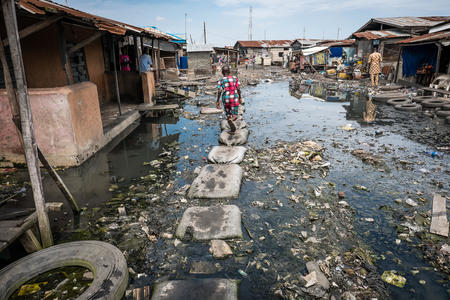The sanitation sector: plenty of passion, so what's missing?

A year after the UN sealed a commitment to achieve universal access to sanitation into the Sustainable Development Goals, WaterAid UK’s Ada Oko-Williams reflects on what the sector needs to change to make this reality.
The passion of sanitation practitioners in the crusade to ensure everyone has a decent toilet by 2030 has got us a long way. By publicly and profusely displaying our enthusiasm for the cause, campaigning for it to be considered by the highest courts, we have broken boundaries and brought dignity to the subject of shit. We have ushered open defecation into UN goals and the public health documents of ministries and agencies.
But we have a long way to go to reach our goal of universal access – the JMP clearly highlights that between 1990 and 2015 global access to sanitation only increased by 13.8% (JMP).
2.3 billion people still only imagine having a toilet that helps them to defecate with dignity, protects them from disease or death, and helps to alleviate poverty. As a sanitation professional I reflect and wonder daily – what are we not doing right? What more can we give to create a greater result? What else can we do to spark the embers and achieve the targets?
I am convinced that we need to change the tempo, the rhythm, and the pace for the sector to experience the move and change we so want to see – access to sustainable sanitation for all by 2030. But how do we do this? What do we not do already, and what can we change?
How can we achieve greater change?
We already understand that our responses and approaches should be multidisciplinary and multidimensional. We ensure interaction between our foci: policy change; developing the right technology, approaches and financing; capacity development; understanding the people we work with; and ensuring everything is contextualised. Interventions and responses should reflect the realities of the people and places where the intervention is carried out. We need to be mindful of how to achieve a delicate balance while looking for scalable solutions – there are no blanket solutions.
We know that a well-coordinated and strengthened sector is imperative. A critical mass exists that is often forgotten and neglected – sanitation workers, the people who work for the sector. We need more and better-supported foot soldiers, especially where it matters most.
At the global level and within key international organisations and development agencies, developed countries have a growing army of sanitation workers This is a good thing because it helps to create better understanding in developed countries of the issues; this leads to increased political will at this level, which influences and informs activities (both donor-led and supported) in developing countries.
But capacity at the point of need is much lower than it is in developed countries. For instance, the membership of SuSanA (Sustainable Sanitation Alliance), a network of sanitation professionals, clearly shows the lopsided capacity of knowledge and expertise between developing and developed countries.
Are ground workers the missing link?
My recent visit to Nigeria brought this point home. In one of the states where WaterAid works and partners with the Government, it was reported that a recruitment embargo on environmental health workers, also known as sanitarians, has been in place for more than ten years. Consequently, within this local government, the lowest ranking sanitarian is on grade 15 – equivalent to a director and two grades below the highest rank in the civil service. This implies that there are no foot soldiers. The level 15 officer is not your regular foot soldier who will work in and with communities to ensure they attain their sanitation goals. There is a gap – no unit of trained, motivated men and women with the understanding and passion to support communities to achieve sustainable sanitation.
This is, I hope, a localised scenario; it might be exclusive to this state. I can’t prove that systematic recruitment, training, equipping, and motivation of ground sanitation experts and workers is not happening across the world. But I am still looking for places where this is happening systemically and the gap does not exist.
How can we fill the gap?
We need to understand how sanitarians, community health extension workers, and environmental health officers can be systemically trained and integrated into mainstream government systems. Is this a missing link in the sector strengthening chain? How can international development organisations deliberately target sanitation workers within the institutions and systems, strengthening their capacities and supporting them to grow, rather than creating parallel systems and specialised teams to support implementation of ‘our’ projects?
How do we make space for the foot soldier sanitarian to get in the limelight? As a sector we need to slow down and understand that, no matter how far up the global agenda we raise our cause, we will continue to see only small increases in access unless we increase capacity and capability on the ground. We need to close the gap and get the job done.




